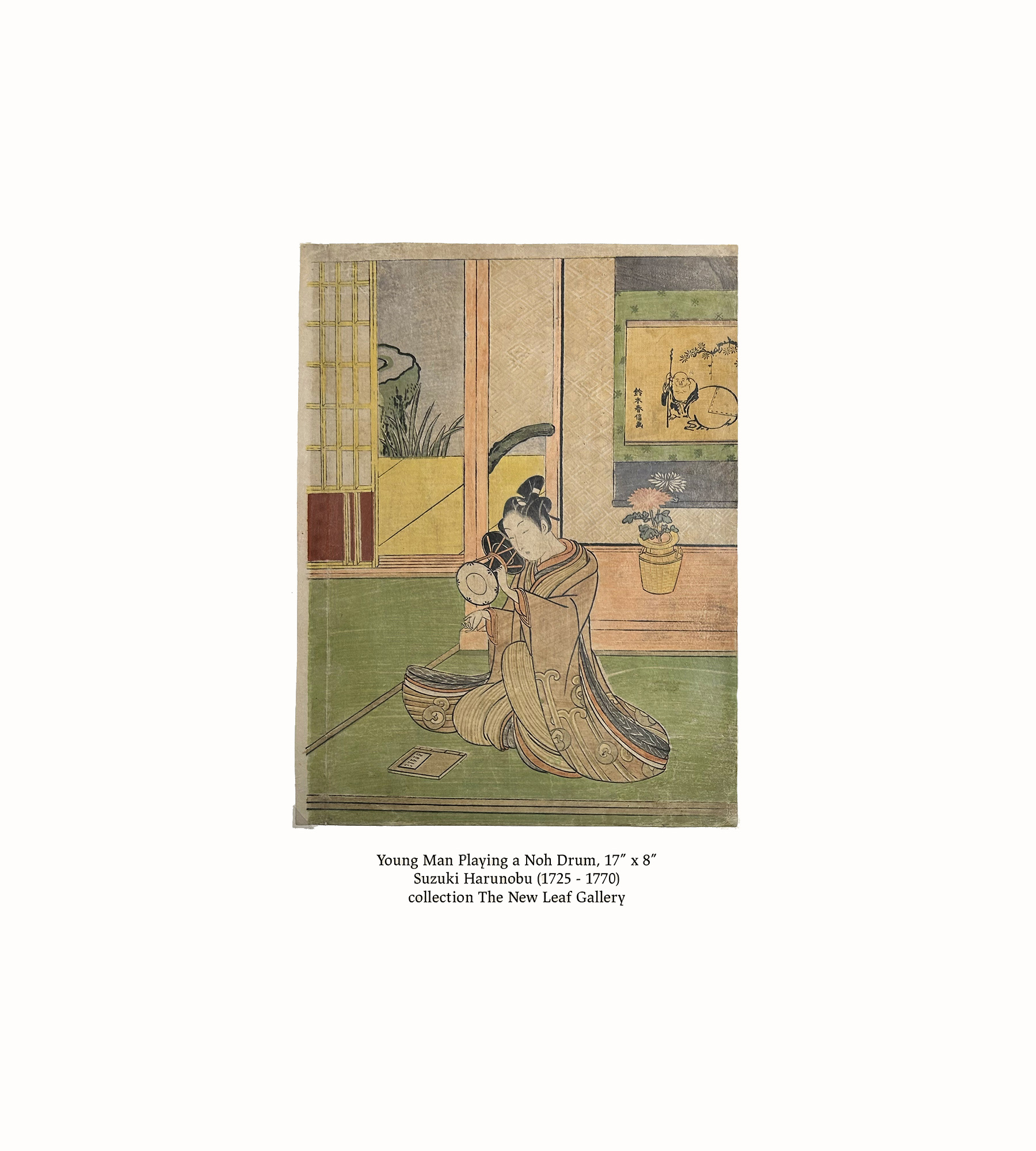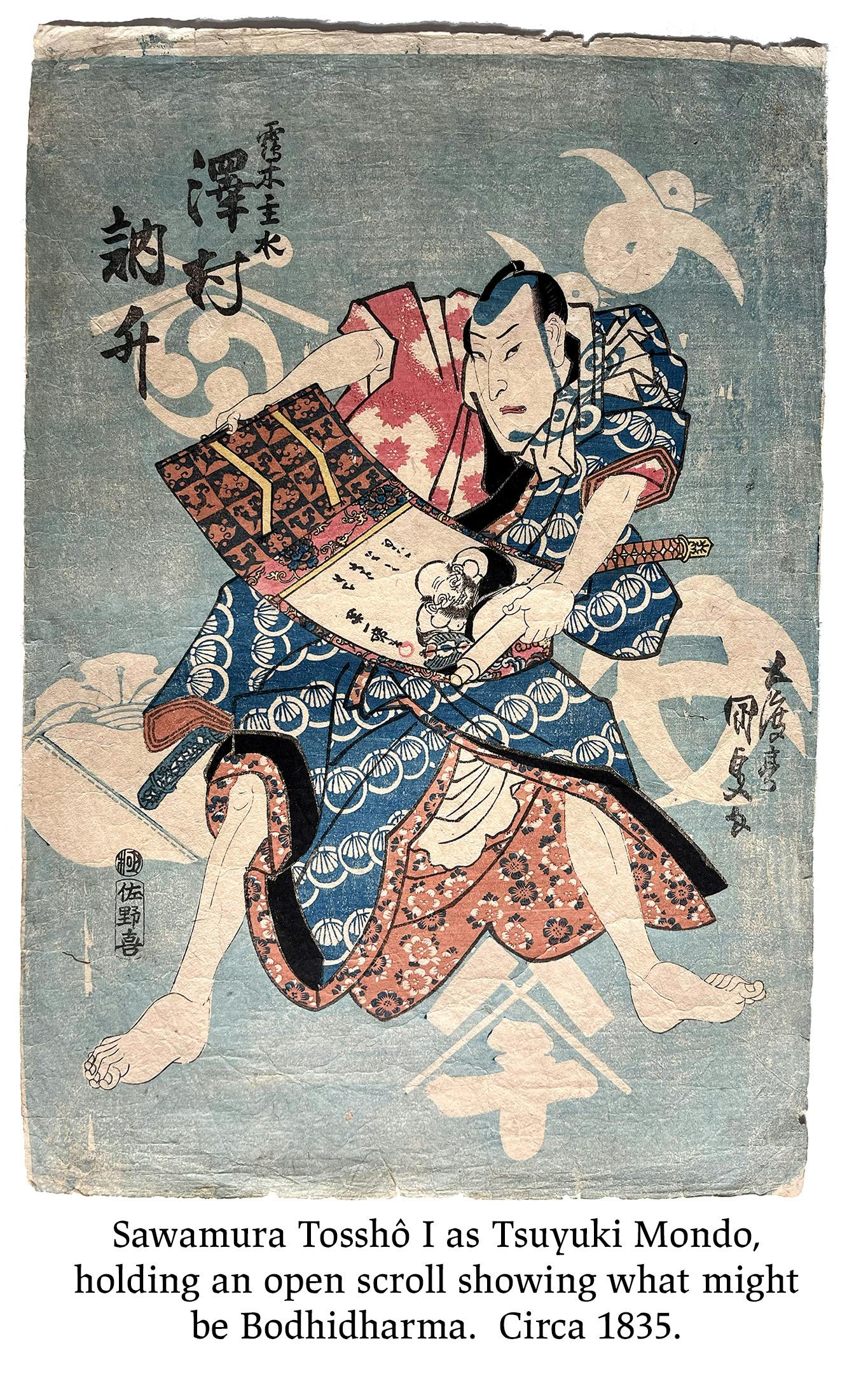Kunisada: Art within Art
February 09 - April 27
Things get interesting when artists depict other art in their artwork:
Dutch masters such as Vermeer and Rubens including in their paintings depictions of other paintings,
Vincent Van Gogh depicting in portraits Japanese prints pinned to walls,
James McNeill Whistler working a pair of framed pictures into his well-known portrait of his mother, Arrangement in Grey and Black.
Harunobu, the pioneering Japanese master of the ukiyo-e woodblock art form, included painted screens and scrolls, ikebana arrangements, and clothing patterns of the fabric industry—the many striking kimonos being worn.
Kunisada, an endlessly inventive print designer, built upon Harunobu's device of depicting art, and art-making, in his print imagery.

The device is like nesting stories within stories in literature. The technique—sometimes called the frame story— offers a multi-layered experience (think Boccaccio’s Decameron, the tales of the One Thousand and One Nights, Shakespeare’s settings of plays within plays). Kunisada's depictions of art within his art encourage this multi-faceted communication.
In Kunisada's world of the Japanese ukiyo-e print tradition, nested stories were used on the printed sheets in multiple ways.
Cartouches describe aspects of people and places depicted, inserted text names actor’s roles and offer short narratives and poems, transactional notations— artist’s signature and publisher's marks, censor seals, sometimes marks of the carvers or printers. These insertions describe the stories of the design and manufacture of the prints, they also deepen the communication of the imagery.
Kunisada excelled in two dominant print arenas: bijn-e (prints of beautiful women) and yakusha-e (prints of kabuki theater imagery). In the imagery of both genres Kunisada keeps our eyes moving, his compositions engage and guide our explorations of his picture spaces. In his bijn-e prints juxtapositions of pattern and depicted persons and objects often use the device of art within art. In his yakusha-e, Kunisada depicts tangible theater spaces which include references to other spaces: backdrops depicting river or mountain landscapes, painted screens showing moving water, patterns of fall leaves, wood-grain, plant patterns. Echoing the convoluted, multi-layered plot-lines of the kabuki plays, Kunisada's yakusha-e prints use strong diagonals, bold gestures and frozen-moment action to bring a theater dynamic to the fixed printed page.
Taylor McNeil and I, in our mutual interest in Kunisada's prints, have long noted Kunisada's depictions of art within his art. We shaped this exhibit not so much to prove Kunisada did this, or to explain why, but to explore the impact of the technique.
Our goal in the effort?
We think the same as what motivated Kunisada: a desire to explore the delight of visual communication!
Matt Brown
Art Within Art, Worlds Within Worlds (Taylor McNeil)
As a collector of woodblock prints by U. Kunisada, I’m continually looking at them and learning from them—or at least trying to. In the early to mid-1800s, when these prints were made, the sprawling city of Edo—now called Tokyo—was a mysterious place. Isolated from the outside world, Japan thrived economically and culturally. People and scenes depicted in these prints represent that very different world. They are for me a rich puzzle, layered with meanings to be deciphered.
Each part of the prints has a story to tell. In what are called beauty prints (bijn-e) it is the graceful woman robed in intricately patterned kimonos—but there’s often the art within the art, sometimes in a cartouche, giving hints of landscapes and locales that print buyers in Edo would recognize. For me this is a mystery to be solved: to what and where in Edo are they pointing, and why?

The kabuki actor prints also hint at connections. In one print from the 1830s, an actor named Sawamura Tosshô I plays a character known as Tsuyuki Mondo, a samurai, who boldly holds open a scroll with a depiction of a bearded monk, perhaps Bodhidharma (the monk who brought Chan Buddhism to China). Symbols are knocked out in white in the blue background around the samurai, one is a bird flying off and another reminds me of the sign of the thunder god. This art depicted in the art, like all of Kunisada’s prints, carried significance for the person who first bought this print almost 200 years ago. For me, it’s a mystery to be appreciated and pondered, an aspect of the richness of Kunisada’s art.
Taylor McNeil
Poem No. 61 by Ise-no-tayu,
from Kunisada's “One Hundred Poems by One Hundred Poets”
woodblock print
14" x 10"
Beauty with scroll by Kôryûsai (Kôryûsai ga), from the series Mirror of Famous Ukiyo-e Artists (Meihitsu ukiyo-e kagami) (1857)
color woodblock print
14" x 10"
$950
Poem No. 97, by Gonchunagon Sadaie, from Kunisada's “One Hundred Poems by One Hundred Poets”, circa 1847
woodblock print
14" x 10"
“The Mimeguri Shrine", from the series “Modern Sparrows of Edo", preparatory drawing (circa mid-1830s)
“The Mimeguri Shrine", from the series “Modern Sparrows of Edo,” circa mid-1830s
woodblock print
14" x 10"
from the series, Customs of the Six Jewel Rivers (Fūzoku Mu-Tamagawa - 風俗六玉川) (chuban size)
color woodblock print
10" x 7.5"
View of Shinobazu, from the series “Pictorial Gathering of Remarkable Women of the Floating World, Part Two” (Ukiyo meijo zue nihen)
woodblock print
14" x 10"
New Higurashi (Shin Higurashi): Double Blossoms, Single Blossoms, Mountain Cherry (Yae, hitoe, yamazakura), from the series Cherry-blossom Viewing Spots in Edo (Edo hanami tsukushi)
color woodblock print
14" x 10"
Sawamura Tosshô I as Tsuyuki Mondo, ca 1835
woodblock print
14" x 10"
Ichikawa Kuzō II as Jjitsu ha Keno, from the play "Hakkenden uwasa no takadono", staged at the Morita Theater in Edo in the fourth month of 1836.
color woodblock print
14" x 30"
Ichikawa Kuzō II as Jjitsu ha Keno, from the play "Hakkenden uwasa no takadono", staged at the Morita Theater in Edo in the fourth month of 1836.
color woodblock print
14" x 30"
Ichikawa Danjuro VII (later known as Ebizō V) in the role of Inutagawa Kobungo, from the play "Hakkenden uwasa no takadono", staged at the Morita Theater in Edo in the fourth month of 1836
color woodblock print
14" x 30"
Eight Famous Views, triptych left (1830)
Eight Famous Views, triptych center (1830)
Eight Famous Views, triptych right (1830)
A Rustic Genji (Genji Moyô Furisode Hinagata), left panel, 1851
A Rustic Genji (Genji Moyô Furisode Hinagata), center panel, 1851
A Rustic Genji (Genji Moyô Furisode Hinagata), right panel, 1851
In the Ichiriki Teahouse at Gion, Chushingura, Act 7, left (1854)
color woodblock print
14" x 30"
In the Ichiriki Teahouse at Gion, Chushingura, Act 7, center (1854)
color woodblock print
14" x 30"
In the Ichiriki Teahouse at Gion, Chushingura, Act 7, right (1854)
color woodblock print
14" x 30"
“The Cart Scene from Triptych shows “The Cart Scene” from the play Sugawara Denju Tenarai Kagami, at the Kawarazaki Theater, 1859, left panel
“The Cart Scene from Triptych shows “The Cart Scene” from the play Sugawara Denju Tenarai Kagami, at the Kawarazaki Theater, 1859, center panel
“The Cart Scene from Triptych shows “The Cart Scene” from the play Sugawara Denju Tenarai Kagami, at the Kawarazaki Theater, 1859, right panel
The Seventh Month, from the 1852 series Twelve Months (Jûni tsuki no uchi)
woodblock print
14" x 10"
Segawa Kikunojō V as Nyōbō Koume in the kabuki play "Tsukuri mono ume no Yoshibei", performed at the Ichimura Theater in Edo
color woodblock print
14" x 10"
Fuji no Kata, from the series The False Murasaki's Rustic Genji (Nise Murasaki Inaka Genji)
woodblock print
14" x 10"
A weaver at her loom, with view of the Nezu Shrine, from Edo Meisho Hyakunin Bijo (One hundred famous places and beauties of Edo)
color woodblock print
14" x 10"
Heating Incense in the Bedroom in Vain, left panel of triptych
woodblock print
14" x 10"
Kawarazaki Gonjuro I as Yoshida no Matsuwaka,
Series: Silhouettes of a Great Variety of Flowering Plants
color woodblock print
14" x 10"
Kunisada with Yellow Patterns
Danjuro VIII as Jiraiya and Bando Shuka I as Princess Tagato (1852)
color woodblock print
14" x 10"
“After Kunisada", acrylic on panel wall relief by Esme Thompson, 2022, (inspired by “Jiraiya and Princess Tagato")